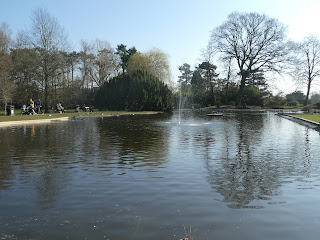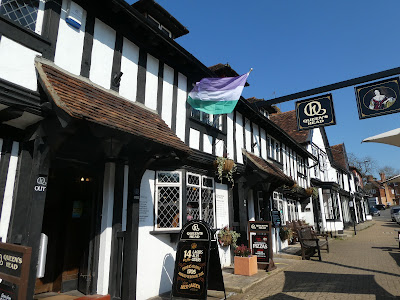Pinner is not the sort of place most people would associate with London. It is leafy suburbia and contains apparently three farms, reflecting it's largely rural character until the village became built up in the first half of the twentieth century.
So starting off, Pinner Memorial Park, a fairly standard London park to be honest
Although it does contain a museum to the illustrator Heath Robinson, sadly closed on a Tuesday, and an aviary populated by budgerigars
It was a long trek to get out here on the Metropolitan line, as this old milestone records for weary travellers heading into London (by carriage)
There are some nice old cottages around this end near Waxwell Lane
As well as the Oddfellows pub
This is the Little Common, which lives up to its name. Only tales a minutes to traverse it
Most of the area seems to have been developed between the wars - this crescent is a particularly nice example of 1920s housing
Waxwell Farm, although no longer a farm, but a big farmhouse, now occupied by some catholic sect.
And this is the Wax Well after which the farm (and Waxwell Lane) were named. It is a medieval spring, and nothing to do with wax, but derived from something Wakeswell, and once the main source of water the area
This is the River Pinn, not exactly a raging torrent.
While it is easy to mock suburbia, wandering around the streets, especially back into Moss Lane, it all does seem very peaceful and charming, and the houses are of generous proportions. It is a world away from Hoxton and my previous day's walk. And far more appealing to be honest.
Predating everywhere else in the area (church excepting) is a little clutch of old farm buildings, the oldest of which is East End Farm Cottage, which apparently dates back to the 15th century. This used to be the hamlet of East End
East End House is rather grander
Further down Moss Lane is a grander house still, and of much more recent vintage. This is Fives Court, an Arts and Crafts House built at the beginning of the twentieth century for Ambrose Heal of the Heal's furnishing store fame.
A little walk up a side street off Moss Lane up Wakehams Hill takes one out onto this unexpected vista of farmland.
Nower Hill Green, with its drinking fountain memorial to 19th century benefactor William Tooke
Now we come to a series of very large old houses, like this one, Elmdene, once home to Ronnie Barker and David Suchet
Grandest of all is Pinner House, a mansion dating from around 1700, at which time it would have had lovely rural views now replaced by suburban housing
A few steps away is St Johns Church, which unlike all the Hoxton churches I came across, was actually open, although empty, so had the place to myself. This is a much more genteel world. It actually dates back to the 14th century although the church had a substantial Victorian makeover thanks to the aforementioned Mt Tooke
The church tower is 15th century
The most curious (by far!) of the churchyard memorials is this pyramid for the parents of designer John Claudius Loudon
The sort of lychgate you would associate with rural village church
The church forms a nice backdrop to the High Street
A High Street which contains a lot of old buildings - far from a modern designed shopping street. Would be lovely without all the traffic. The Queens Head pub has apparently been a public house since the reign of Charles I
As a nice postcript to this walk, I went for a drink with a young mate of mine from the office only to learn he had moved to Pinner just before first lockdown, so I had virtually walked past his house the day before. I sort of envy him (but not the commute....)
















































No comments:
Post a Comment